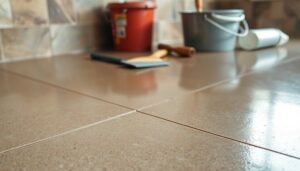DIY fiber board waterproofing can save you money by extending the life of your windows and preventing costly repairs. Start by cleaning the fiber board and sealing any cracks with silicone caulk. Then, apply a water-resistant primer followed by an exterior-grade acrylic paint for durability. This creates a strong moisture barrier, enhancing energy efficiency and reducing your energy bills by up to 25%. Regular maintenance, like reapplying paint every 5-10 years and inspecting caulking, guarantees your windows stay in top shape. As you explore, you'll discover even more tips to maximize your savings and keep your windows looking great.
Benefits of Fiber Board Waterproofing
When it comes to protecting your home, fiber board waterproofing offers several significant benefits. First and foremost, it creates a robust barrier against moisture, drastically reducing the risk of water damage and mold growth. By regularly maintaining your fiber board, you'll guarantee that your window frames last longer, potentially saving you significant replacement costs down the line. Additionally, utilizing budgeting tools can help you allocate funds for regular maintenance, ensuring your home remains protected and financially secure. Moreover, using tools like YNAB (You Need A Budget) can aid in planning your expenses effectively.
Additionally, waterproofing with fiber board can enhance your home's energy efficiency. With fewer air leaks and moisture intrusions, you might notice a decrease in your energy bills, making your home more comfortable and cost-effective.
Another advantage is the aesthetic appeal it brings to your windows. Regular waterproofing treatments help maintain the appearance of your windows over time, keeping them looking fresh and new.
Finally, fiber board provides a cost-effective solution compared to traditional materials. You'll enjoy similar durability without breaking the bank. Additionally, consistent maintenance aligns with monitoring savings and investments to support long-term home value retention.
Materials Needed for DIY Project
To commence your DIY fiber board waterproofing project, you'll need a few key materials to guarantee the job is done right. First, invest in high-quality exterior-grade acrylic paint. This will enhance durability and moisture resistance, ensuring long-lasting protection for your windows. Additionally, utilizing tools like expense tracking tools can help manage costs associated with your project, making it easier to stay within budget.
Next, grab a caulking gun along with silicone caulk to seal any gaps effectively. This will create a solid moisture barrier around window frames and joints, further enhancing the protection against water damage.
Before applying any waterproofing materials, it's important to clean the surfaces thoroughly. Use microfiber cloths and a mild detergent to remove dirt and debris. For a deeper clean, consider using a pressure washer to tackle tougher grime, making sure the surface is pristine before you start the waterproofing process. Utilizing receipt scanning technology can help you organize your project expenses efficiently.
Don't forget to protect yourself during this project! Wear gloves and masks to avoid exposure to harmful vapors from adhesives and paint.
Once you've applied the waterproofing materials, let it dry completely before exposing the area to moisture. Additionally, you should schedule payment alerts to ensure you can budget for any maintenance costs associated with your windows. With these materials on hand, you're well on your way to achieving a successful DIY fiber board waterproofing project.
Step-by-Step Waterproofing Process

Start the waterproofing process by thoroughly cleaning the fiber board with a mild detergent and a soft-bristle brush. This'll help remove any dust and debris that could interfere with the waterproofing application. Implementing a clear financial tracking strategy can help you allocate funds for maintenance projects effectively. Utilizing budget apps can streamline your spending management during home improvement tasks.
Once it's clean, inspect the fiber board for any cracks or gaps. Make certain to use a high-quality silicone caulk to seal these areas, creating a moisture barrier.
Next, apply a water-resistant primer specifically designed for fiber board. This step enhances adhesion and adds an extra layer of protection against moisture.
After the primer dries, choose a high-quality exterior-grade acrylic paint for the final coat. This paint will provide durability and further waterproofing. Tracking expenses with accurate categorization can help you stay within your budget for materials.
Remember to reapply the paint every 5-10 years for peak performance. Regularly inspect your work to check for any signs of wear.
If you notice any issues, reapply sealants or paint as necessary to prevent moisture damage. Following these steps will guarantee your fiber board remains waterproof and extends its lifespan, saving you money on window maintenance in the long run. Additionally, consider prioritizing sustainable options during your home maintenance projects to contribute to overall environmental responsibility.
Maintenance Tips for Longevity
Maintaining your fiber board's waterproofing is vital for long-lasting durability and protection against moisture damage. Regularly inspect the caulking around your windows, and reseal any gaps with silicone caulk. This simple home improvement task prevents moisture intrusion, which can lead to mold and structural damage over time. Additionally, establishing a regular maintenance schedule can help you develop disciplined savings habits similar to those promoted by budgeting apps. Regular inspections and maintenance can also enhance control over your home's condition, preventing costly repairs in the future.
Make it a habit to clean your fiber cement siding annually with a soft-bristle brush and mild detergent. This helps remove dirt and prevents mold buildup, maintaining both appearance and durability. Additionally, keep your gutters and downspouts clear of debris to guarantee they function properly, diverting water away from your windows and siding.
Repainting your fiber cement siding every 5 to 15 years is essential. Use high-quality, exterior-grade acrylic paint to protect against the elements and extend the lifespan of your siding.
Finally, apply weatherstripping to window seals each year. This not only improves insulation but also enhances energy efficiency, ultimately reducing long-term repair costs associated with potential water damage. Establishing a regular maintenance schedule can also foster disciplined savings habits and help you allocate funds effectively for home upkeep.
Cost Savings and Energy Efficiency

Cost savings and energy efficiency go hand in hand when you invest in proper maintenance for your fiber board and windows.
By regularly checking and sealing gaps and cracks around the edges, you can greatly improve your home's insulation and reduce drafts. This simple task, done at least twice a year, can lead to a remarkable 25% reduction in your energy costs, translating to an average savings of $200 annually on energy bills. Additionally, utilizing coupon codes for related maintenance supplies can further enhance your savings. Engaging in conscious consumerism ensures that the materials you use for maintenance are both effective and environmentally friendly.
Utilizing energy-efficient materials like fiber board not only enhances thermal performance but also lowers heating and cooling expenses.
When you address minor window repairs promptly, you prevent extensive damage that could cost you thousands in replacements or structural repairs.
The ROI on your DIY maintenance efforts can be as high as 75%, boosting your home's value while slashing energy expenses. Additionally, employing automated savings tools can help you allocate funds specifically for home maintenance and improvements.
Conclusion
By taking on DIY fiber board waterproofing, you not only protect your windows but also save money in the long run. Did you know that homes with proper waterproofing can reduce energy costs by up to 20%? That's a significant amount! With the right materials and a bit of effort, you can enhance your home's durability and efficiency. So, roll up your sleeves and get started—your windows (and wallet) will thank you!



